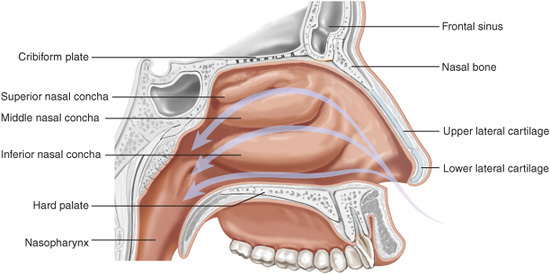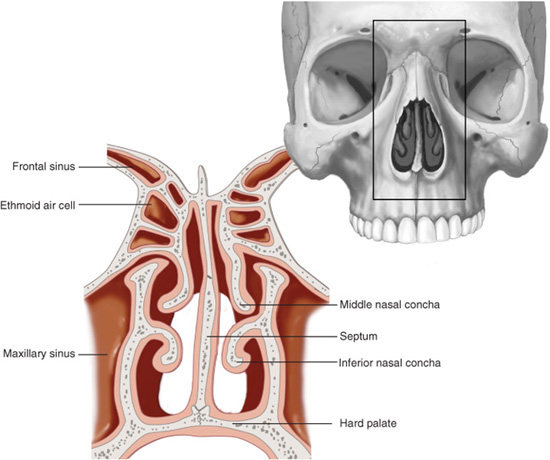Chapter 7. Treatment Planning: Nasal Function
 Nasal function: For numerous reasons, breathing through the nose is more beneficial than breathing through the mouth. Humidification occurs as the air passes from the nose to the lungs. In fact, 90% of humidification occurs before the air reaches the lungs across the turbinates (Figures 7-1 and 7-2). Air can be heated as much as 25°C to 30°C during inspiration, and the nose plays a large role in thermal regulation.1,2 Particulate filtration occurs in the nasal vibrissae just inside the nares where large particles may be trapped. Impingement is a process where smaller particles are filtered, and the two areas where this occurs are the internal nasal valve and the posterior nasopharynx. The mucociliary system also plays a major role in particulate filtration.3
Nasal function: For numerous reasons, breathing through the nose is more beneficial than breathing through the mouth. Humidification occurs as the air passes from the nose to the lungs. In fact, 90% of humidification occurs before the air reaches the lungs across the turbinates (Figures 7-1 and 7-2). Air can be heated as much as 25°C to 30°C during inspiration, and the nose plays a large role in thermal regulation.1,2 Particulate filtration occurs in the nasal vibrissae just inside the nares where large particles may be trapped. Impingement is a process where smaller particles are filtered, and the two areas where this occurs are the internal nasal valve and the posterior nasopharynx. The mucociliary system also plays a major role in particulate filtration.3
Figure 7-1. Lateral nasal sidewall anatomy.
Figure 7-2. Nasal cavity cross-section.
 Nasal physiology: As one breathes through the nose, the regular pace of the respiratory cycle is maintained. Afferent stimuli from nerve endings in the nose travel to the brain to control the rhythm and rate of breathing. Additionally, the brain senses the efflux of carbon dioxide and responds by maintaining a normal tone in the pulmonary vasculature and a normal production of mucus. Breathing through the mouth bypasses these nerve endings, disrupting the respiratory cycle and stimulating the brain to produce larger amounts of mucus and increase pulmonary vascular resistance. Chronic increases in vascular resistance lead to pulmonary hypertension. With expiration, air exits the nose across a smaller cross-sectional area, which creates back-pressure in the respiratory tree. This keeps the terminal alveoli open longer permitting more time for gas exchange. Too rapid a loss of carbon dioxide, as occurs with hyperventilation, alters the pH of the blood.4
Nasal physiology: As one breathes through the nose, the regular pace of the respiratory cycle is maintained. Afferent stimuli from nerve endings in the nose travel to the brain to control the rhythm and rate of breathing. Additionally, the brain senses the efflux of carbon dioxide and responds by maintaining a normal tone in the pulmonary vasculature and a normal production of mucus. Breathing through the mouth bypasses these nerve endings, disrupting the respiratory cycle and stimulating the brain to produce larger amounts of mucus and increase pulmonary vascular resistance. Chronic increases in vascular resistance lead to pulmonary hypertension. With expiration, air exits the nose across a smaller cross-sectional area, which creates back-pressure in the respiratory tree. This keeps the terminal alveoli open longer permitting more time for gas exchange. Too rapid a loss of carbon dioxide, as occurs with hyperventilation, alters the pH of the blood.4
 Nasal cycle: Normally, there is a cyclical enlargement and contraction of the nasal mucosa that alternates between nostrils: When one side is engorging, the other is contracting. This cycle may take between 1 and 5 hours and its purpose is unknown.3
Nasal cycle: Normally, there is a cyclical enlargement and contraction of the nasal mucosa that alternates between nostrils: When one side is engorging, the other is contracting. This cycle may take between 1 and 5 hours and its purpose is unknown.3
 History: Many factors are considered in elucidating the etiology of nasal obstructive symptoms: duration, frequency, laterality, and seasonality. The patient should be questioned about a history of trauma, allergies, and medications. Seasonal or geographic symptoms are typical of a disorder that is best treated medically. Obstruction only in deep inspiration or heavy breathing is characteristic of a collapsed internal nasal valve, whereas an obstruction that is constant is indicative of a fixed mechanical obstruction such as an enlarged turbinate or septal deviation.
History: Many factors are considered in elucidating the etiology of nasal obstructive symptoms: duration, frequency, laterality, and seasonality. The patient should be questioned about a history of trauma, allergies, and medications. Seasonal or geographic symptoms are typical of a disorder that is best treated medically. Obstruction only in deep inspiration or heavy breathing is characteristic of a collapsed internal nasal valve, whereas an obstruction that is constant is indicative of a fixed mechanical obstruction such as an enlarged turbinate or septal deviation.
Stay updated, free articles. Join our Telegram channel

Full access? Get Clinical Tree




 External examination
External examination